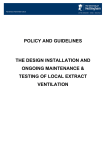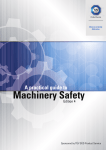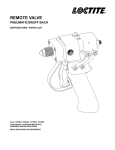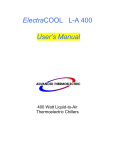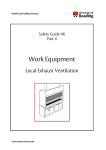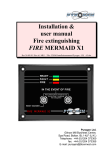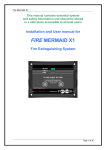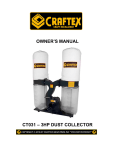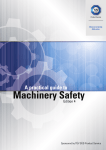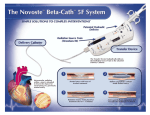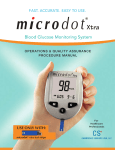Download Installation
Transcript
Automatic Bollard User Manual Genie MkII Installation This is a confidential document and must not be copied, used, or its contents divulged (in whole or in part) without the prior consent of ATG Access Ltd. Furthermore use of components other than those permitted herein, or modifications or enhancements that have not been approved by ATG Access will invalidate the warranty or approval of this product Hard copies of this document are uncontrolled Form No: accOMGII Rev: E Issue Date: Jan 06 Change: Radio receiver was shown remote. 2 Automatic Bollard User Manual Genie MkII Installation This is a confidential document and must not be copied, used, or its contents divulged (in whole or in part) without the prior consent of ATG Access Ltd. Furthermore use of components other than those permitted herein, or modifications or enhancements that have not been approved by ATG Access will invalidate the warranty or approval of this product Hard copies of this document are uncontrolled Form No: accOMGII Rev: E Issue Date: Jan 06 Change: Radio receiver was shown remote. 4 Automatic Bollard User Manual Genie MkII Installation Table of Contents CONVENTIONS USED IN THIS MANUAL..................................................................................... 7 HEALTH AND SAFETY .................................................................................................................. 9 COSHH.......................................................................................................................................... 9 Hazards Identification................................................................................................................. 9 Electrical Safety........................................................................................................................... 9 Handling ..................................................................................................................................... 10 Operational Safety .................................................................................................................... 10 Maintenance............................................................................................................................... 10 ABOUT YOUR GENIE MKII BOLLARD ....................................................................................... 11 Specification .............................................................................................................................. 11 Choosing the bollard location ................................................................................................. 12 Drainage ................................................................................................................................................12 INSTALLATION............................................................................................................................. 13 Unpacking the unit .................................................................................................................... 13 Preparing the site ...................................................................................................................... 13 Outer casing installation .......................................................................................................... 14 Inner assembly installation...................................................................................................... 16 Removing the lid...................................................................................................................................16 Electrical cable .....................................................................................................................................16 Re-assembly .........................................................................................................................................16 ELECTRICAL INSTALLATION..................................................................................................... 17 Basic installation....................................................................................................................... 17 Extending the cable run – Method 1 ....................................................................................... 18 Extending the cable run – Method 2 ....................................................................................... 19 Dual Units – Method 1............................................................................................................... 20 Dual Units – Method 2............................................................................................................... 21 ELECTRICAL CONNECTIONS .................................................................................................... 23 APPENDIX A: AEROSHELL FLUID 41........................................................................................ 25 Hazards Identification............................................................................................................... 25 First Aid Measures .................................................................................................................... 25 Advice to Doctor........................................................................................................................ 25 Fire Fighting Measures............................................................................................................. 26 Accidental Release Measures.................................................................................................. 26 This is a confidential document and must not be copied, used, or its contents divulged (in whole or in part) without the prior consent of ATG Access Ltd. Furthermore use of components other than those permitted herein, or modifications or enhancements that have not been approved by ATG Access will invalidate the warranty or approval of this product Hard copies of this document are uncontrolled Form No: accOMGII Rev: E Issue Date: Jan 06 Change: Radio receiver was shown remote. 5 Automatic Bollard User Manual Genie MkII Installation Handling and Storage ............................................................................................................... 26 Exposure Controls ...............................................................................................................................26 Respiratory Protection.........................................................................................................................27 Hand Protection....................................................................................................................................27 Eye Protection ......................................................................................................................................28 Body Protection....................................................................................................................................28 Environmental Exposure Controls .....................................................................................................28 Ecological Information ............................................................................................................. 28 Waste, Product and Container Disposal ................................................................................ 28 This is a confidential document and must not be copied, used, or its contents divulged (in whole or in part) without the prior consent of ATG Access Ltd. Furthermore use of components other than those permitted herein, or modifications or enhancements that have not been approved by ATG Access will invalidate the warranty or approval of this product Hard copies of this document are uncontrolled Form No: accOMGII Rev: E Issue Date: Jan 06 Change: Radio receiver was shown remote. 6 Automatic Bollard User Manual Genie MkII Installation CONVENTIONS USED IN THIS MANUAL The following conventions are used throughout this manual to highlight particular points. 1 Text in this style is information which is particularly important in order to understand the operation of the system. 2 This symbol and text style indicates that the associated text contains important safety information which must not be ignored. 3 This symbol and text style indicates that the associated text contains important information relating to electrical safety which must not be ignored. This is a confidential document and must not be copied, used, or its contents divulged (in whole or in part) without the prior consent of ATG Access Ltd. Furthermore use of components other than those permitted herein, or modifications or enhancements that have not been approved by ATG Access will invalidate the warranty or approval of this product Hard copies of this document are uncontrolled Form No: accOMGII Rev: E Issue Date: Jan 06 Change: Radio receiver was shown remote. 7 Automatic Bollard User Manual Genie MkII Installation This is a confidential document and must not be copied, used, or its contents divulged (in whole or in part) without the prior consent of ATG Access Ltd. Furthermore use of components other than those permitted herein, or modifications or enhancements that have not been approved by ATG Access will invalidate the warranty or approval of this product Hard copies of this document are uncontrolled Form No: accOMGII Rev: E Issue Date: Jan 06 Change: Radio receiver was shown remote. 8 Automatic Bollard User Manual Genie MkII Installation HEALTH AND SAFETY VERY IMPORTANT SAFETY NOTE: A Genie MkII automatic bollard installation does not include safety devices such as an inductive inhibit loop. Therefore it is imperative that, in operation, the bollard is clearly visible to the vehicle driver and that he or she can confirm visually that the bollard has:1) fully lowered or 2) that it is not rising in front of the approaching vehicle. COSHH The following information is given to ensure that operators and maintenance personnel are adequately informed with regard to Aeroshell Fluid 41 oil used in the systems as this is the only substance that falls under the COSHH remit. The information contained herein has been extracted from Safety Data Sheet number 001A0050 dated 11/11/04 published by Shell UK Products Limited. It is included as a guide only for the purpose of health, safety and environmental requirements and should not be taken as conclusive. Further information is included in Appendix A of this manual. Hazards Identification EC Classification Not classified as Dangerous under EC criteria Human Health Hazards No specific hazards under normal use conditions. Prolonged or repeated exposure may give rise to dermatitis. Used oil may contain harmful impurities. Safety Hazards Not classified as flammable, but will burn. Environmental Hazards Not classified as dangerous for the environment. Electrical Safety The pump in the hydraulic power pack used to raise and lower the GENIE MKII bollard is driven by a single phase mains electric motor. The control unit is also powered from a single phase mains supply. There is therefore the risk of electric shock, injury or even death. Only fully trained and experienced electrical engineers should work on this equipment and the isolating switch provided on the control unit must be switched to the OFF position before commencing work. Tampering with the equipment in the control unit by untrained staff may adversely affect the performance of the system and could result in malfunction or unsafe operation. This is a confidential document and must not be copied, used, or its contents divulged (in whole or in part) without the prior consent of ATG Access Ltd. Furthermore use of components other than those permitted herein, or modifications or enhancements that have not been approved by ATG Access will invalidate the warranty or approval of this product Hard copies of this document are uncontrolled Form No: accOMGII Rev: E Issue Date: Jan 06 Change: Radio receiver was shown remote. 9 Automatic Bollard User Manual Genie MkII Installation Handling The ATG Access Genie MkII bollard is a heavy item, (135Kg total weight), which requires care when handling. Suitable lifting practices in line with Health and Safety Law should be observed and appropriate safety equipment used in line with the Personal Protective Equipment Regulations. The GENIE MKII bollard is too heavy for one person to safely handle. Handling needs to be carried out in compliance with Manual Handling Operations Regulations and where possible mechanical handling aids should be employed. Operational Safety When giving a verbal instruction to a person who is to be given authority to proceed through a bollard system it is imperative that a clear, short and concise message is given in order to ensure safe passage for that person and vehicle. Whilst it may be argued that this is common sense it will remove any doubts or ambiguities from the situation. Maintenance When carrying out maintenance on the bollard system it is imperative that the area is adequately protected. This is to ensure that the person carrying out the work is protected whilst working and also to ensure that pedestrians cannot come to harm as a result of the work. Please read this manual completely and familiarise yourself fully with the contents before commencing installation. This is a confidential document and must not be copied, used, or its contents divulged (in whole or in part) without the prior consent of ATG Access Ltd. Furthermore use of components other than those permitted herein, or modifications or enhancements that have not been approved by ATG Access will invalidate the warranty or approval of this product Hard copies of this document are uncontrolled Form No: accOMGII Rev: E Issue Date: Jan 06 Change: Radio receiver was shown remote. 10 Automatic Bollard User Manual Genie MkII Installation ABOUT YOUR GENIE MKII BOLLARD The GENIE MKII is a hydraulically operated rising bollard assembly suitable for installation in domestic driveways and to protect private parking bays. The unit is designed to be easily installed by a competent technician. Some tasks will require assistance with lifting. Bollard diameter 101mm Specification Cable supplied Operations operation The diagram on the right shows a GENIE MKII bollard installed in the ground. 500 925 Bollard rise time Bollard lower time Power required 101mm 500mm 115 Kg. Brushed stainless steel 7 seconds 7 seconds 240v single phase Fused at 20 amps 10 metres, 4 core 50 per day maximum Not continuous 150 Bollard diameter Bollard height Bollard weight Bollard finish 50mm electrical duct The main dimensions are shown. The top of the GENIE MKII assembly is shown in the drawing on the left. The unit must be installed so that the vehicles approach at 90 degrees to the curved edge. The small removable flap gives access to a manual override valve which is operated by a special key. This allows the bollard to be lowered in the event of mains failure. VEHICLE APPROACH DIRECTION This is a confidential document and must not be copied, used, or its contents divulged (in whole or in part) without the prior consent of ATG Access Ltd. Furthermore use of components other than those permitted herein, or modifications or enhancements that have not been approved by ATG Access will invalidate the warranty or approval of this product Hard copies of this document are uncontrolled Form No: accOMGII Rev: E Issue Date: Jan 06 Change: Radio receiver was shown remote. 11 Automatic Bollard User Manual Genie MkII Installation Choosing the bollard location Consideration should be given to the following points. • Are there any underground services or obstructions which may interfere with the installation? A CAT scan of the area must be undertaken before commencing excavation • Is there a sufficiently clear view of the proposed location to give adequate time for vehicle drivers to react? • Is there adequate illumination with regard to safety at the proposed site? • With safety in mind, is there a need for inductive loops, photo electric beams or traffic indicator lights to control the system? • Has a sufficient number of bollards been specified to successfully control vehicular access? Maximum recommended distance between GENIE MKII bollards is 1.5 metres. Drainage Drainage must be provided to prevent the accumulation of water within the casing. • A good soak away must be created at the bottom of the required excavation and the bottom cap supplied must then be drilled to provide drain holes. • An optional bottom cap can be provided, to special order, for the connection of 50mm plastic waste pipe which should be run to a suitable drain. • In areas where the water table is high consideration should be given to completely sealing the supplied bottom cap in position with waterproof tape to prevent water ingress. If this is done then the GENIE MKII inner assembly must be periodically lifted out and any standing water removed. This is a confidential document and must not be copied, used, or its contents divulged (in whole or in part) without the prior consent of ATG Access Ltd. Furthermore use of components other than those permitted herein, or modifications or enhancements that have not been approved by ATG Access will invalidate the warranty or approval of this product Hard copies of this document are uncontrolled Form No: accOMGII Rev: E Issue Date: Jan 06 Change: Radio receiver was shown remote. 12 Automatic Bollard User Manual Genie MkII Installation INSTALLATION Unpacking the unit The GENIE MKII bollard is delivered as a complete assembly. The packing must be carefully removed and the unit then separated into its two main component parts. Remove the two countersunk bolts at the top of the bollard assembly and remove the circular lid. Then remove the retaining screw and the over-ride flap. Remove the screws which attach the main lid to the outer casing assembly. Raise the lid along its straight edge and slide it back, disengaging the retention bayonets. The lid may then be lifted clear of the casing. The whole assembly should now be lowered into a horizontal position and rested along the flat edge of the box unit. One person should firmly grasp the top of the inner assembly around the fixing flange whilst a second supports the inner tube through the bottom of the outer casing. The inner assembly should now be slid out of the outer casing taking great care not to damage the hydraulic hoses. The supplied standard bottom plastic cap or alternative special drainage cap should be fitted after which the outer casing is ready to be installed into the prepared hole. Note: If a suitable drain connection is not available drainage holes must be drilled in the bottom cap to allow water to escape. An adequate soak away must also be created at the bottom of the excavation. Preparing the site A CAT scan of the area must be undertaken before commencing excavation. A hole will be required in the road surface approximately 500mm by 500mm square and 1100mm deep. Provision should be made for connection to a suitable drain or, alternatively, a soak-away should be created to ensure that the installation remains clear of standing water. The top 300mm depth of the hole must be opened out to 700mm diameter. Ducting is required from the unit to the control unit. Provision is made within the unit for the entry of a 50mm diameter duct. The connecting cable carries 240 volts ac and is therefore subject to IEE regulations. These currently require that mains cables are buried a minimum of 500mm below the finished road surface and are identified with electrical marking tape. This is a confidential document and must not be copied, used, or its contents divulged (in whole or in part) without the prior consent of ATG Access Ltd. Furthermore use of components other than those permitted herein, or modifications or enhancements that have not been approved by ATG Access will invalidate the warranty or approval of this product Hard copies of this document are uncontrolled Form No: accOMGII Rev: E Issue Date: Jan 06 Change: Radio receiver was shown remote. 13 Automatic Bollard User Manual Genie MkII Installation Outer casing installation If a suitable drain connection is not available then a soak away must be created at the bottom of the hole before proceeding. Pea shingle should be poured into the hole until its level is approximately 915mm below finished ground level. Additional pea shingle should then be poured into the hole and compacted to hold the casing firmly in position. INITIAL PEA SHINGLE 915 mm BELOW GROUND LEVEL The height of the unit must be adjusted by the addition or removal of pea shingle until the top of the casing is 10mm above finished ground level at the lowest point. TOP 300mm OF HOLE OPENED OUT TO 700mm Dia EXCAVATION APPROXIMATELY 1100 mm DEEP The outer casing should then be positioned in the hole with the curved edge of the box lid at 90º to, and facing, the direction of traffic flow. TOP OF CASING MUST BE 10 mm PROUD OF GROUND LEVEL COMPACTED PEA SHINGLE The casing should be checked regularly for vertical alignment during this procedure. The top of the assembly must be set 10mm above the finished ground level to divert water away from the unit. The casing MUST be installed so that it is vertical in all planes. TOP OF CASING MUST BE 10 mm PROUD OF GROUND LEVEL TOP 300mm OF HOLE OPENED OUT TO 700mm Dia Complete the installation of the pea shingle which should finish approximately 300mm below ground level. The final task is to fill the remaining area of the hole with concrete. EXCAVATION APPROXIMATELY 1100 mm DEEP Ensure that the duct is protruding at least 200mm inside the top of the casing. 300 mm LEAVE DUCT PROUD OF CASING ABOUT 200mm FINAL PEA SHINGLE LEVEL AFTER INSTALLATION OF DUCT With the casing firmly secured, vertically true and at the correct height the 50mm diameter electrical duct should be inserted in the cut-out provided. COMPACTED PEA SHINGLE This is a confidential document and must not be copied, used, or its contents divulged (in whole or in part) without the prior consent of ATG Access Ltd. Furthermore use of components other than those permitted herein, or modifications or enhancements that have not been approved by ATG Access will invalidate the warranty or approval of this product Hard copies of this document are uncontrolled Form No: accOMGII Rev: E Issue Date: Jan 06 Change: Radio receiver was shown remote. 14 Automatic Bollard User Manual Genie MkII Installation Using a C35 mix, carefully pour concrete into the hole until it is level with the finished road surface. TOP OF CASING MUST BE 10 mm PROUD OF GROUND LEVEL 300 mm CONCRETE If the duct is allowed to fall below the level of the casing cut-out, concrete may find its way inside the duct. This will almost certainly then set around the pull cord and possibly completely block the duct. This will make it impossible to pull the electrical cable into the duct. AFTER CONCRETE HAS SET CUT EXCESS DUCT OFF TO JUST PROUD OF INNER CASING EXCAVATION APPROXIMATELY 1100 mm DEEP Ensure that the electrical duct is protruding at least 200mm inside the casing. The duct may be held in position with tape and excess length can easily be removed later. COMPACTED PEA SHINGLE If the surrounding area is of block or set stone construction the concrete should be dyed as necessary to complement and blend in with the pattern. Make sure that the casing does not move out of alignment during this process. After the concrete has fully set, cut off the excess duct so that it is just proud of the bottom of the casing. This is a confidential document and must not be copied, used, or its contents divulged (in whole or in part) without the prior consent of ATG Access Ltd. Furthermore use of components other than those permitted herein, or modifications or enhancements that have not been approved by ATG Access will invalidate the warranty or approval of this product Hard copies of this document are uncontrolled Form No: accOMGII Rev: E Issue Date: Jan 06 Change: Radio receiver was shown remote. 15 Automatic Bollard User Manual Genie MkII Installation Inner assembly installation Under no circumstances should the supplied cable, connected to the hydraulic pump unit, be shortened. Doing so will invalidate the warranty and make future servicing difficult.. Removing the lid Remove the single fixing screw retaining the override flap and remove the flap. Remove the five fixing screws and slide the lid away from the straight edge as far as it will go. This will allow the bayonet pins to be lifted from the keyhole slots and the lid to be removed. Remove the bollard lid, retained by two screws. Carefully lower the bollard inner assembly into the outer casing, taking care not to damage the hydraulic hoses which run down the length of the assembly. Care should be taken to rotate the unit into correct alignment before finally lowering the last 150mm. As the inner assembly is finally lowered, although the unit is self-locating, some gentle manipulation may be required to align the inner tube in the guide blocks at the bottom of the outer casing. Great care should be taken during this procedure to ensure that fingers are not trapped between the outer casing and main assembly. The use of suitable lifting gear is strongly recommended. Electrical cable Attach the end of the supplied four-core cable to the draw rope previously inserted in the duct. The cable should then be pulled through the duct and clear of the assembly. Excess cable can be safely coiled up within the casing, if required. Re-assembly Refit the bollard lid, ensuring it is the correct way up, and secure it with the two screws supplied. Ensure that the bollard is fully retracted before attempting to refit the case lid. Offer the lid up to the top of the assembly and slide it back beyond the straight edge until the bayonet pins drop into position through the keyhole slots. Slide the lid forward into position and secure it with the five fixing screws supplied. Re-fit the over-ride flap and tighten the screw. This is a confidential document and must not be copied, used, or its contents divulged (in whole or in part) without the prior consent of ATG Access Ltd. Furthermore use of components other than those permitted herein, or modifications or enhancements that have not been approved by ATG Access will invalidate the warranty or approval of this product Hard copies of this document are uncontrolled Form No: accOMGII Rev: E Issue Date: Jan 06 Change: Radio receiver was shown remote. 16 Automatic Bollard User Manual Genie MkII Installation ELECTRICAL INSTALLATION The control unit supplied with the Genie MkII automatic bollard houses the main controller board and the radio receiver pcb. The radio receiver pcb is mounted on the main control pcb. The control unit is shown in the photograph on the right. The following notes are a general guide only as each installation will have its own specific requirements. Some common situations are described and illustrated. On no account must the supplied 4 core cable, connected to the bollard hydraulic pump unit, be shortened. Any surplus cable must be neatly coiled and secured before connecting the wire ends into the appropriate terminals. Failure to comply will make future servicing difficult and invalidate the warranty. Control Unit with built-in Radio Receiver 240 volt Electrical Supply 8 metres maximum Supplied cable in conduit Underground Duct Basic installation The diagram above illustrates a basic installation where the control unit is located within eight metres of the bollard position. The ten metres of supplied cable allows for the 500mm drop into the underground duct and a metre or so to run up a wall or post into the control unit. The final length of 4 core cable, running up the wall or post, must be installed in conduit or otherwise suitably protected. All wiring must be in accordance with current electrical regulations. This is a confidential document and must not be copied, used, or its contents divulged (in whole or in part) without the prior consent of ATG Access Ltd. Furthermore use of components other than those permitted herein, or modifications or enhancements that have not been approved by ATG Access will invalidate the warranty or approval of this product Hard copies of this document are uncontrolled Form No: accOMGII Rev: E Issue Date: Jan 06 Change: Radio receiver was shown remote. 17 Automatic Bollard User Manual Genie MkII Installation Extending the cable run – Method 1 If the control unit is to be installed some distance from the bollard position the arrangement shown in the diagram below may be utilised. Control Unit with built-in Radio Receiver Junction Box on wall or post Suitable 4 core extension cable (cable size dependant on distance) 8 metres maximum 240 volt Electrical Supply Supplied cable in conduit Underground Duct The length of cable supplied with the GENIE MKII unit is run to a junction box within 8 metres from the bollard. The necessary length of extension cable can then be joined within the junction box. The extension cable can then be taken to the control unit position. All wiring must be in accordance with current electrical regulations. If the junction box will be exposed to the elements then it must have an IP rating to suit those conditions. The supplied 4 core cable must not be cut as this will invalidate the warranty and make future servicing difficult. This is a confidential document and must not be copied, used, or its contents divulged (in whole or in part) without the prior consent of ATG Access Ltd. Furthermore use of components other than those permitted herein, or modifications or enhancements that have not been approved by ATG Access will invalidate the warranty or approval of this product Hard copies of this document are uncontrolled Form No: accOMGII Rev: E Issue Date: Jan 06 Change: Radio receiver was shown remote. 18 Automatic Bollard User Manual Genie MkII Installation Extending the cable run – Method 2 If the control unit is to be installed some distance from the bollard position and the use of a junction box is not desirable the arrangement shown in the diagram below may be utilised. Control Unit with built-in Radio Receiver Cable supplied coiled inside casing and connected to extension cable by means of a waterproof joint Conduit (not required for SWA cable) 240 volt Electrical Supply Suitable 4 core extension cable in duct (cable size dependant on distance) The length of 4 core cable supplied with the GENIE MKII unit must be carefully coiled up within the bollard housing. There is ample space within the housing to do this. The supplied 4 core cable must not be cut as this will invalidate the warranty and make future servicing difficult. The necessary length of four core extension cable can then be joined within the bollard housing making sure that the joint is waterproof. The extension cable can then be taken to the control unit position via an underground duct. All wiring must be in accordance with current electrical regulations. This is a confidential document and must not be copied, used, or its contents divulged (in whole or in part) without the prior consent of ATG Access Ltd. Furthermore use of components other than those permitted herein, or modifications or enhancements that have not been approved by ATG Access will invalidate the warranty or approval of this product Hard copies of this document are uncontrolled Form No: accOMGII Rev: E Issue Date: Jan 06 Change: Radio receiver was shown remote. 19 Automatic Bollard User Manual Genie MkII Installation Dual Units – Method 1 Where two GENIE MKII units are installed the arrangement shown in the diagram below may be utilised. Control Unit with built-in Radio Receiver 240 volt Electrical Supply 8 metres maximum Supplied cables in trunking Maximum Pitch 1.5 Metres A separate duct must be run from each GENIE MKII bollard to the control unit location. The furthest bollard must be within 8 metres of the control unit. The length of cable supplied with each GENIE MKII can then be passed via suitable trunking up into the control unit. All wiring must be in accordance with current electrical regulations. Neither of the supplied 4 core cables must be cut as this will invalidate the warranty and make future servicing difficult. This is a confidential document and must not be copied, used, or its contents divulged (in whole or in part) without the prior consent of ATG Access Ltd. Furthermore use of components other than those permitted herein, or modifications or enhancements that have not been approved by ATG Access will invalidate the warranty or approval of this product Hard copies of this document are uncontrolled Form No: accOMGII Rev: E Issue Date: Jan 06 Change: Radio receiver was shown remote. 20 Automatic Bollard User Manual Genie MkII Installation Dual Units – Method 2 An alternative method where two GENIE MKII units are installed is shown in the diagram below. This allows the control unit to be positioned some distance from the bollard positions. Control Unit with built-in Radio Receiver Junction Box on wall or post Suitable extension cable (size dependant on distance) 240 volt Electrical Supply 8 metres maximum Supplied cables in conduit Maximum Pitch 1.5 Metres Inspection Pit A separate duct must be run from each GENIE MKII bollard to the edge of the carriageway. The furthest bollard must be within 8 metres of this position. The length of 4 core cable supplied with each GENIE MKII can then be passed via suitable trunking up into a junction box. All wiring must be in accordance with current electrical regulations. Neither of the supplied 4 core cables must be cut as this will invalidate the warranty and make future servicing difficult. The necessary length of 4 core extension cable can then be joined within the junction box making sure that the joint is waterproof. The four core extension cable can then be taken to the control unit position via a suitable conduit or duct. This is a confidential document and must not be copied, used, or its contents divulged (in whole or in part) without the prior consent of ATG Access Ltd. Furthermore use of components other than those permitted herein, or modifications or enhancements that have not been approved by ATG Access will invalidate the warranty or approval of this product Hard copies of this document are uncontrolled Form No: accOMGII Rev: E Issue Date: Jan 06 Change: Radio receiver was shown remote. 21 Automatic Bollard User Manual Genie MkII Installation This is a confidential document and must not be copied, used, or its contents divulged (in whole or in part) without the prior consent of ATG Access Ltd. Furthermore use of components other than those permitted herein, or modifications or enhancements that have not been approved by ATG Access will invalidate the warranty or approval of this product Hard copies of this document are uncontrolled Form No: accOMGII Rev: E Issue Date: Jan 06 Change: Radio receiver was shown remote. 22 Automatic Bollard User Manual Genie MkII Installation ELECTRICAL CONNECTIONS Only fully trained and experienced electrical engineers should work on this equipment and the incoming mains supply must be isolated before commencing work. Details of the connections for the electrical mains supply and the supplied four core cable to the pump unit are given in a separate ATG Access manual. See “AUTOMATIC BOLLARD USER MANUAL, GENIE MKII CONTROLS” for full information on the connection and commissioning of the Genie MKII automatic bollard. This is a confidential document and must not be copied, used, or its contents divulged (in whole or in part) without the prior consent of ATG Access Ltd. Furthermore use of components other than those permitted herein, or modifications or enhancements that have not been approved by ATG Access will invalidate the warranty or approval of this product Hard copies of this document are uncontrolled Form No: accOMGII Rev: E Issue Date: Jan 06 Change: Radio receiver was shown remote. 23 Automatic Bollard User Manual Genie MkII Installation This is a confidential document and must not be copied, used, or its contents divulged (in whole or in part) without the prior consent of ATG Access Ltd. Furthermore use of components other than those permitted herein, or modifications or enhancements that have not been approved by ATG Access will invalidate the warranty or approval of this product Hard copies of this document are uncontrolled Form No: accOMGII Rev: E Issue Date: Jan 06 Change: Radio receiver was shown remote. 24 Automatic Bollard User Manual Genie MkII Installation Appendix A: Aeroshell Fluid 41 The information contained herein has been extracted from Safety Data Sheet number 001A0050 dated 11/11/04 published by Shell UK Products Limited. It is included as a guide only for the purpose of health, safety and environmental requirements and should not be taken as conclusive. Hazards Identification EC Classification Not classified as Dangerous under EC criteria Human Health Hazards No specific hazards under normal use conditions. Prolonged or repeated exposure may give rise to dermatitis. Used oil may contain harmful impurities. Safety Hazards Not classified as flammable, but will burn. Environmental Hazards Not classified as dangerous for the environment. First Aid Measures Not expected to give rise to an acute hazard under normal conditions of use. Inhalation In the unlikely event of dizziness or nausea, remove casualty to fresh air. If symptoms persist obtain medical advice. Skin Remove contaminated clothing and wash affected skin with soap and water. If persistent irritation occurs obtain medical attention. If high pressure injection injuries occur obtain medical attention immediately. Eyes Flush affected eyes with copious quantities of water. If persistent irritation occurs obtain medical attention. Ingestion Wash out the mouth with water and obtain medical attention. Do not induce vomiting. Advice to Doctor Treat symptomatically. Aspiration into the lungs may cause chemical pneumonitis. Dermatitis may result from prolonged or repeated exposure. High pressure injection injuries require surgical intervention and possibly steroid therapy to minimise tissue damage and loss of function Because entry wounds are small and do not reflect the seriousness of the underlying damage, surgical exploration to determine the extent of involvement may be necessary. Local anaesthetics or hot soaks should be avoided because they can contribute to swelling, vasospasm and ischaemia. Prompt surgical decompression, debridement and evacuation of foreign material should be performed under general anaesthetics, and wide exploration is essential. There may be a risk to health where low viscosity products are aspirated into the lungs following vomiting, although this is uncommon in adults. Such aspiration would cause intense local irritation and chemical pneumonitis. Children, and those in whom consciousness is impaired, will be more at risk. Emesis of lubricants is not usually necessary, unless a large amount has been ingested, or some other compound has been dissolved in the product. If this is indicated, for example, when there is rapid onset of central nervous system depression from large ingested volume, gastric lavage under controlled hospital conditions, with full protection of the airway is required. This is a confidential document and must not be copied, used, or its contents divulged (in whole or in part) without the prior consent of ATG Access Ltd. Furthermore use of components other than those permitted herein, or modifications or enhancements that have not been approved by ATG Access will invalidate the warranty or approval of this product Hard copies of this document are uncontrolled Form No: accOMGII Rev: E Issue Date: Jan 06 Change: Radio receiver was shown remote. 25 Automatic Bollard User Manual Genie MkII Installation Supportive care may include oxygen, arterial blood gas monitoring, respiratory support, and, if aspiration has occurred, treatment with corticosteroids and antibiotics. Seizures should be controlled with Diazepam, or appropriate equivalent drug. Fire Fighting Measures Combustion is likely to give rise to a complex mixture of airborne solid and liquid particulates and gases, including carbon monoxide and unidentified organic and inorganic compounds. Foam and dry chemical powder, carbon dioxide, sand or earth may be used for small fires only. Do not use jets of water. Use of halon extinguishers should be avoided for environmental reasons. Suitable protective equipment including breathing apparatus must be worn when approaching a fire in a confined space. Accidental Release Measures Avoid contact with skin and eyes. Wear PVC, Neoprene or nitrile rubber gloves. Wear rubber knee length safety boots, PVC jacket and trousers. Wear safety glasses if splashes are likely to occur. Prevent from spreading or entering drains, ditches or rivers by using sand, earth or other appropriate barriers. Inform the local authorities if this cannot be prevented. Absorb liquid with sand or earth. Sweep up and remove to a suitable, clearly marked container for disposal in accordance with local regulations. Handling and Storage Handling Use local exhaust ventilation if there is a risk of inhalation of vapours, mists or aerosols. Avoid prolonged or repeated contact with skin. When handling product in drums safety footwear should be worn and suitable handling equipment should be used. Prevent spillages. Cloth, paper and other materials that are used to absorb spills present a fire hazard. Avoid their accumulation by disposing of them safely and immediately. In addition to any specific recommendations given for controls of risks to health, safety and the environment, an assessment of risks must be made to help determine controls appropriate to local circumstances. Exposure to this product should be reduced as low as reasonably practicable. Reference should be made to the Health and Safety Executive publication ‘COSHH Essentials’. Storage Keep in a cool, dry, well ventilated place. Use properly labelled and closeable containers. Avoid direct sunlight, heat sources and strong oxidising agents. The storage of this product may be subject to the Control of Pollution (Oil Storage) (England) Regulations. Further guidance may be obtained from the local Environmental Agency office. Storage temperature should be between 0°C minimum and 50°C maximum. For containers or container linings use mild steel or high density polyethylene. PVC should be avoided. Polyethylene containers should not be exposed to high temperatures because of possible risk of distortion. Exposure Controls The use of personal protective equipment is only one aspect of an integrated approach to the Control of Substances Hazardous to Health. The management of Health and Safety at Work Regulations 1992 require employers to identify and evaluate the risks to health and to implement appropriate measures to eliminate or minimise those risks. This is a confidential document and must not be copied, used, or its contents divulged (in whole or in part) without the prior consent of ATG Access Ltd. Furthermore use of components other than those permitted herein, or modifications or enhancements that have not been approved by ATG Access will invalidate the warranty or approval of this product Hard copies of this document are uncontrolled Form No: accOMGII Rev: E Issue Date: Jan 06 Change: Radio receiver was shown remote. 26 Automatic Bollard User Manual Genie MkII Installation The choice of personal protective equipment is highly dependent upon local conditions, e.g. exposure to other chemical substances and micro-organisms, thermal hazards (protection from extremes of cold and heat), electrical hazards, mechanical hazards and appropriate degree of manual dexterity require to undertake an activity Whilst the content of this section may inform the choice of personal protective equipment used, the limitations of any information which can be provided must be fully understood, e.g. personal protective equipment chosen to protect employees from occasional splashes may be entirely inadequate for activities involving partial or complete immersion. If the levels of oil mist or vapour in air are likely to exceed the occupational exposure standards, then consideration should be given to the use of local exhaust ventilation to reduce personal exposure. The choice of personal protective equipment should only be undertaken in the light of a full risk assessment by a suitably qualified competent person (e.g. a professionally qualified occupational hygienist). Effective protection is only achieved by correctly fitting and well maintained equipment and employers should ensure that appropriate training is given. All personal protective equipment should be regularly inspected and replaced if defective. Reference should be made to HSE’s publication Methods for the Determination of Hazardous Substances (MDHS) 84 – Measurement of oil mist from mineral oil-based metalworking fluids. Measurement of an employee’s exposure to oil vapour may be supplemented through the use of stain tubes. In the first instance, further guidance may be obtained through HSE’s publication ‘COSHH – a brief guide to the regulations’ (INDG 136(rev 1)). Respiratory Protection At standard temperature and pressure, the Occupational Exposure Standard for oil vapour is unlikely to be exceeded. Care should be taken to keep exposures below applicable occupational exposure limits. In the unlikely event that this cannot be achieved use of a respirator fitted with an organic vapour cartridge combined with a particulate pre-filter should be considered. If product is subjected to elevated temperatures, half masks (EN 149) or valved half masks (EN 405) in combination with type AX (EN 371) and P2/3 (EN 143) pre-filters maybe considered. Hand Protection Chemical protective gloves are made from a wide range of materials, but there is not a single glove material, (or combination of materials), which gives unlimited resistance to any individual or combination of substances or preparations. The extent of the breakthrough time will be affected by a combination of factors which include permeation, penetration, degradation, use pattern (full immersion, occasional contacts) and how the glove is stored when not in use. Theoretical maximum levels of protection are seldom achieved in practice and the actual level of protection can be difficult to assess. Effective breakthrough time should be used with care and a margin of safety should be applied. HSE guidance on protective gloves recommends a 75% safety factor be applied to any figures obtained in a laboratory test. Nitrile gloves may offer relatively long breakthrough times and slow permeation rates. Test data, e.g. breakthrough data obtained through test standard EN 374-3:1994, are available from reputable equipment suppliers. Personal hygiene is a key element of effective hand care. Gloves must only be worn on clean hands. After using gloves, hands should be washed and dried thoroughly. A non perfumed moisturiser should be applied. This is a confidential document and must not be copied, used, or its contents divulged (in whole or in part) without the prior consent of ATG Access Ltd. Furthermore use of components other than those permitted herein, or modifications or enhancements that have not been approved by ATG Access will invalidate the warranty or approval of this product Hard copies of this document are uncontrolled Form No: accOMGII Rev: E Issue Date: Jan 06 Change: Radio receiver was shown remote. 27 Automatic Bollard User Manual Genie MkII Installation Eye Protection Goggles conforming to a minimum standard of EN 166 345B should be considered if there is a possibility of eye contact with the product through splashing. Higher rated eye protection must be considered for highly hazardous operations or work areas. Body Protection Minimise all forms of skin contact. Overalls and shoes with oil resistant soles should be worn. Launder overalls and undergarments regularly. Environmental Exposure Controls Minimise release to the environment. An environmental assessment must be made to ensure compliance with local environmental legislation. Ecological Information This information is based on knowledge of the product components and the ecotoxicology of similar products. The product is liquid under most environmental conditions and will float on water. Product is not expected to be readily biodegradable. Major constituents are expected to be inherently biodegradable but the product contains components that may persist in the environment. Also contains components with the potential to bioaccumulate. Product is a poorly soluble mixture. It may cause physical fouling of aquatic organisms but is expected to be practically non-toxic to them. Chronic effects to aquatic organisms are not expected at concentrations less than 1 mg/l. Not expected to have ozone depletion potential, photochemical ozone potential or global warming potential. Product is a mixture of non-volatile components which are not expected to be released into the air in any significant quantities. Waste, Product and Container Disposal Recycle or dispose of the product with an authorised contractor in accordance with prevailing regulations. Do not pollute the soil, water or environment with the product. This is a confidential document and must not be copied, used, or its contents divulged (in whole or in part) without the prior consent of ATG Access Ltd. Furthermore use of components other than those permitted herein, or modifications or enhancements that have not been approved by ATG Access will invalidate the warranty or approval of this product Hard copies of this document are uncontrolled Form No: accOMGII Rev: E Issue Date: Jan 06 Change: Radio receiver was shown remote. 28
































